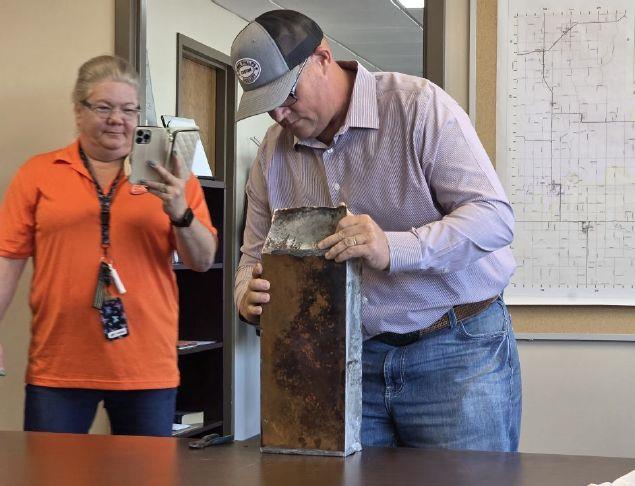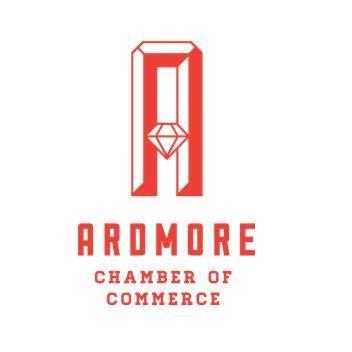Documents passed down by Ardmore and Carter County’s forefathers saw the light of day for the first time in over a century.
A time capsule that was buried in the cornerstone of the Carter County Courthouse in 1911 was opened Thursday morning in the Carter County offices. Inside the capsule was a Bible, the Constitution, a letter from then Governor Lee Cruce, newspapers and an array of county and city documents. The original specifications for the courthouse were also included.
“There is a lot of history in that little box,” County Commission Chairman Berry Lee-Brinkman said. “I definitely feel like a little kid in a candy shop. It is amazing to look through this box and find so many names from our community’s past. It is surreal.
“I am so glad that we can share this with our community.”
Lee-Brinkman said the capsule was supposed to have been opened in 2011 and there has been talk over the years about removing it from the cornerstone.
“After all the renovations that have been done since then until now, we thought it was imperative to pull this capsule,” he said.
County officers, employees and interested onlookers filled the commission chambers to see history revealed. Lee-Brinkman went through several bits before he was able to remove the top and start removing the contents of the capsule. Chad Williams, the director of the research division for the Oklahoma Historical Society was on-hand to assist and preserve the contents, which will be scanned and placed in a shadow box in the courthouse.
“It is not a huge box, but there is only so much space in a cornerstone,” he said. “But with paper, and of course, today we think we have all this technology, and we think of digital. Everything was paper in 1911, and you can put a lot, there is a lot in there. There are documents, newspapers and a list of organizations.
“It is amazing what you can get in a box. But the key is always, will it survive the 100 years.”
Among the highlights was Special District Judge Carson Brooks reading a letter from Governor Cruce to his great-great-grandfather James H. Mathers, apologizing for being unable to attend the laying of the cornerstone in 1911. Mathers served as the county attorney. Brooks, who was named after Mathers’ son James Carson Mathers, said it was hard to believe.
“It is a very surreal feeling,” Brooks said. “It makes me a little emotional because I wish my mother and grandmother were here to see it. It is amazing that it is direct family history.”
Brooks also read from a court docket that had been placed in the capsule, with crimes such as uninspected meat, disturbing public worship, selling liquor, selling whiskey and transporting whiskey listed.
Former County Commissioner Kevin Robinson, who served in the position for 25 years, was among the early arrivals. Like many others, he could not believe how well the documents had been preserved.
“It is the most amazing thing,” Robinson said. “It is unbelievable that it is in that good a shape and I know that once the air hits it, it won’t stay that way.”
Robinson said the commission had done a great job in getting the historical society involved to assist with preservation. He also paid tribute to the county commission for having the fortitude to renovate and restore the courthouse.
“It is awesome, that old courthouse has always been a big part of county government,” he said. “It is the people’s house, and it is a masterpiece.”
Steven Harris, who is among the foremost local historians, was present for the opening of the capsule with several pictures that were taken in 1911, when the cornerstone was laid. Among the items that he was interested in was a roster for the United Confederate Veterans. Those men were in one of his pictures of the old Confederate home.
“If you can figure out the names to the people, it identifies the majority of the people standing in front of the home,” he said. “From a historical standpoint, that is a great asset.”
Harris has an extensive local historical collection, but there were some surprises, which included a copy of the Ardmore Morning Star, a newspaper that he had been unaware of.
“There is a lot of information that was just discovered that was probably findable,” he said. “But having it just laid out in once place, it is a wonderful gift from a historical standpoint.”
Williams, who has attended his fair share of capsule openings, said the newspapers were among the items that stood out to him. He was also not surprised by the different Ardmore newspapers that were represented from a time when there was no internet or television.
“The newspapers that were in the time capsule told the history,” he said. “Every newspaper in Oklahoma is a snapshot of their community, and it is so important.”
He read over several headlines, including one that proclaimed the new $125,000 courthouse the “Best West of the Mississippi River.”
“Those moments in time that tell people today what people in 1911 were thinking, what they were doing and how they were living their lives,” he said. “I think newspapers to me are the most important thing that we collect on the Oklahoma Historical Society because of that snapshot of the community.”



